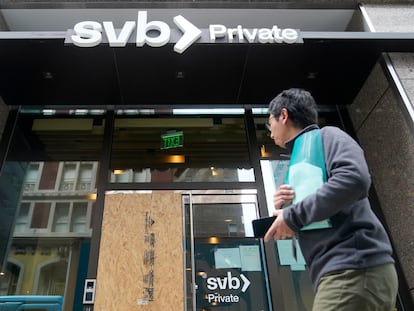Is my money safe? What you need to know about bank failures
The recent failures of Silicon Valley Bank and Signature Bank may have you worried about your money

The recent failures of Silicon Valley Bank and Signature Bank, which catered mostly to the tech industry, may have you worried about your money. They were the second- and third-biggest bank failures in US history.
It all started last week when too many depositors tried to withdraw their money from Silicon Valley Bank in Santa Clara, California. That’s known as a bank run. The bank had to sell treasury bonds and other securities at a steep loss and more people kept trying to withdraw money as word of the situation spread, causing the bank to fail.
Regulators took control of New York-based Signature Bank soon after, saying it was necessary to protect depositors after too many people withdrew money. In response, regulators guaranteed all deposits at the two banks and created a program to help shield other banks to shield them from a run on deposits.
Here’s what you need to know.
Is my money safe?
Yes, if your money is in a bank insured by the Federal Deposit Insurance Corp. and you have less than $250,000 there. If the bank fails, you’ll get your money back.
Nearly all banks are FDIC insured. You can look for the FDIC logo at bank teller windows or on the entrance to your bank branch.
Credit unions are insured by the National Credit Union Administration.
If you have over $250,000 in one bank, which most people don’t, that amount is considered uninsured and experts recommend that you move the remainder of your money to a different financial institution, said Caleb Silver, editor in chief of Investopedia, a financial media website.
Federal officials have been taking steps to make sure other banks aren’t impacted.
“You shouldn’t be too concerned about your money if it’s in one of the bigger banks, and even in some of the regional banks and the credit unions,” Silver said.
Can I tell if my bank will fail?
If you are worried about your bank closing in the near future, there are some things you can watch out for, according to Silver: watch the stock price of your bank; keep an eye on the quarterly and annual reports from your bank; and start a Google alert for your bank in case there are news stories about it.
You want to make sure you pay close attention to the way your bank is behaving, Silver said. “If they’re trying to raise money through a share offering or if they’re trying to sell more stock, they might have trouble on their balance sheet,” said Silver.
Should I look for alternatives?
If you have more than $250,000 in your bank, there are a few things you can do, like open a joint account. You can protect up to $500,000 by opening a joint account with someone else, such as your spouse, said Greg McBride, chief financial analyst at Bankrate, a financial services company. “A married couple can easily protect a million dollars at the same bank by each having an individual account and together having a joint account,” McBride said.
You can also move to another financial institution. Moving your money to other financial institutions and having up to $250,000 in each account will ensure that your money is insured by the FDIC, McBride said.
But do not withdraw cash. Despite the recent uncertainty, experts don’t recommend withdrawing cash from your account. Keeping your money in financial institutions rather than in your home is safer, especially when the amount is insured. “It’s not a time to pull your money out of the bank,” Silver said.
Even people with uninsured deposits usually get nearly all of their money back. “It takes time, but generally all depositors – both insured and uninsured – get their money back,” said Todd Phillips, a consultant and former attorney at the FDIC. “Uninsured depositors may have to wait some time, and may have to take haircut where they lose 10 to 15% of their savings, but it’s never zero.”
Sign up for our weekly newsletter to get more English-language news coverage from EL PAÍS USA Edition
Tu suscripción se está usando en otro dispositivo
¿Quieres añadir otro usuario a tu suscripción?
Si continúas leyendo en este dispositivo, no se podrá leer en el otro.
FlechaTu suscripción se está usando en otro dispositivo y solo puedes acceder a EL PAÍS desde un dispositivo a la vez.
Si quieres compartir tu cuenta, cambia tu suscripción a la modalidad Premium, así podrás añadir otro usuario. Cada uno accederá con su propia cuenta de email, lo que os permitirá personalizar vuestra experiencia en EL PAÍS.
¿Tienes una suscripción de empresa? Accede aquí para contratar más cuentas.
En el caso de no saber quién está usando tu cuenta, te recomendamos cambiar tu contraseña aquí.
Si decides continuar compartiendo tu cuenta, este mensaje se mostrará en tu dispositivo y en el de la otra persona que está usando tu cuenta de forma indefinida, afectando a tu experiencia de lectura. Puedes consultar aquí los términos y condiciones de la suscripción digital.
More information
Archived In
Últimas noticias
Most viewed
- Oona Chaplin: ‘I told James Cameron that I was living in a treehouse and starting a permaculture project with a friend’
- Reinhard Genzel, Nobel laureate in physics: ‘One-minute videos will never give you the truth’
- Sinaloa Cartel war is taking its toll on Los Chapitos
- Why the price of coffee has skyrocketed: from Brazilian plantations to specialty coffee houses
- Silver prices are going crazy: This is what’s fueling the rally










































